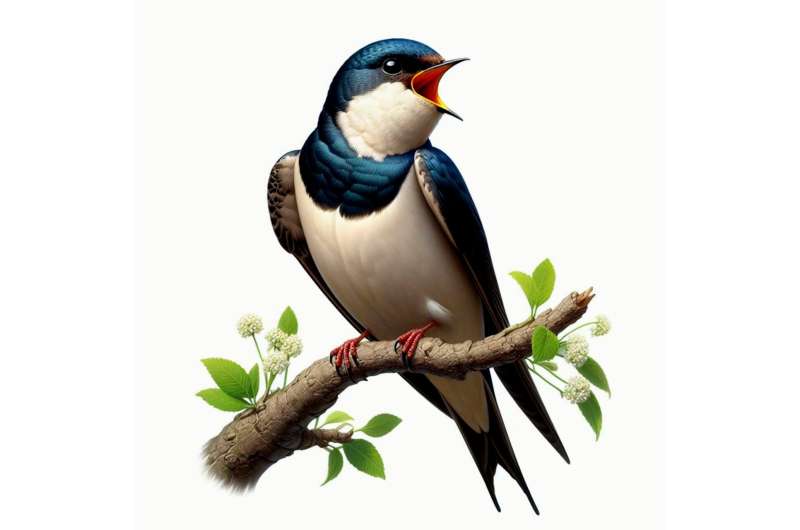This article has been reviewed according to Science X's editorial process and policies. Editors have highlighted the following attributes while ensuring the content's credibility:
fact-checked
trusted source
written by researcher(s)
proofread
Swifts need more nest boxes, but that alone won't be enough. Here's why

Swifts need two things. Safe, dry, nest holes high up on walls and lots of flying insects to eat—but both are in decreasing supply.
Nice, neat roof lines on modern housing, free from cracks and crevices, do not make for good swift hospitality. Campaigners are calling for the widespread installation of swift boxes or bricks in new builds to provide safe nesting spaces for these migratory birds to raise their chicks.
Studies show that these bricks work. Swifts are attracted to them and occupancy rates can be high. But research indicates that these bricks and boxes alone may not be enough to support the struggling swift population.
Despite the provision of large numbers of boxes across the country, figures from the annual breeding bird survey (published by the British Trust for Ornithology, RSPB and Joint Nature Conservation Committee) show a continued decline—60% over the last 25 years.
In 2022, in collaboration with researchers from RSPB and Rothamsted Research, I analyzed data on swifts held in the archives of the British Trust for Ornithology. This study considered the whole life cycle, looking not only at nesting success, but also mortality rates.
We found that, although data on nest success is limited, there was little evidence that a change over time was causing the decline. Flying aphids form a major food source for swifts, so an apparent long-term decline in aphid numbers in the south-east of Britain is particularly intriguing. Swift chicks have the ability to vary the rate at which they grow, so they can pause growth when food supply drops—further work is needed to understand exactly how food supply influences breeding success.
Swift survival
Known as "devil birds" for their screaming call, and their habit of nesting in crevices in tall buildings, which would once have essentially meant church towers, swifts are one of nature's true specialists. Denizens of African skies, they are the last migratory species to arrive in Britain in early May, then among the first to leave. Some birds head south again by early July, just three months later. Most are gone by August.
Once on the wing, they land only to breed. They base themselves in holes in vertical surfaces from which they can easily launch themselves back into flight.
Swifts breeding in China travel nearly 30,000km each year—one of the longest migrations of any bird. Yet, instead of flying the shortest route, they detour to track arid habitats, possibly because their breeding range stretched northwards following the last ice age.
European swifts only cover around half this distance, but it's still a hazardous route across both the Mediterranean and the Sahara. Despite this, annual mortality is relatively low. Around 80% of adult birds return to breed each year.
Young birds have a harder time of it. Preparing for a life on the wing can be difficult. Swifts have an unusually variable chick development period once hatched—anywhere between 35 and 60 days, depending on conditions in a given year. When it is colder, chicks will take longer to grow until they are ready to fledge and leave the nest.
When swifts can't find enough food during prolonged periods of cold weather, they enter a state of torpor. This tactic is usually associated with mammals and involves lowering the body temperature overnight to conserve energy and reduce their daily food requirements.
Even with these adaptations, the proportion of young birds surviving their first migration is low, especially in colder, wetter summers, and seems to have decreased in recent decades.
Further evidence that breeding represents a major energetic challenge comes from my work on the closely related alpine swift. A study published in 2020 found that fewer adults survived when breeding conditions were more difficult—that's indicated by a high rate of ejection of eggs from the nest during incubation. This not only happens during the breeding season, survival is reduced on the subsequent southwards migration too as individuals presumably set out in poorer condition.
So, when you've had a tough breeding season, making the long journey south becomes more of a challenge.
Knowing this, we used the British Trust for Ornithology data to see how important nesting success and survival were for the changing population size. We found that the changes in survival over the first year of life best explained the observed population decline.
However, we were unable to look at how many nests were actually occupied, so it was impossible to say exactly how important the loss of nest sites, on their own, has been in contributing to the national decline.
From the housing shortage and the insect apocalypse to changing climate pressures, a combination of factors are probably responsible for the sharp decline in swift numbers.
Our ability to change the landscape, through building towns, using land for farming or the widespread chemical pollution, both deliberately and accidentally, is much greater than the capacity for wildlife to respond and adapt accordingly.
So while putting up more swift boxes represents a positive change, only a suite of solutions that addresses all aspects of the swift's life cycle can ensure this iconic bird will grace our skies for decades to come.
Provided by The Conversation
This article is republished from The Conversation under a Creative Commons license. Read the original article.![]()



















